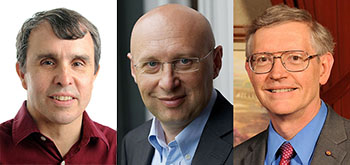
Betzig, Hell, and Moerner. [Images: Matt Staley, HHMI/Wikimedia Commons/K. Lowder via Wikimedia Commons]
A day after the awarding of the 2014 Physics laurels to the inventors of blue LEDs, optics once again took the Nobel Prize spotlight, as this year’s Chemistry prize went to three scientists for pushing past the limits of conventional light microscopes.
The three 2014 Chemistry laureates—Eric Betzig of the Howard Hughes Medical Institute, USA; Stefan Hell of the Max Planck Institute for Biophysical Chemistry, Germany; and William Moerner of Stanford University, USA—were honored for the development of super-resolved fluorescence microscopy. This family of techniques, developed independently by the three honorees over the period from 1989 to the early 2000s, uses lasers or weak light pulses to irradiate extremely small volumes and even individual molecules and toggle on and off their fluorescence. The developments revolutionized the ability of scientists to image and explore at the nanoscale, and cracked open the Abbe diffraction limit for conventional optical microscopy, which limits the tiniest object that can be resolved by ordinary microscopes to no more than half the wavelength of light.
The creation of these techniques marked a classic example of how developments in optics can enable entirely new branches of science. Though only in widespread use since 2000, the techniques pioneered by Betzig, Hell, and Moerner have already been used to study the structure and dynamics of proteins, as well as spawning the disciplines of single-molecule spectroscopy and microscopy, which have enabled a wealth of new observations in chemistry and biology operating at the nanoscale—visualizing, for example, how molecules create new synapses between nerve cells in the brain, and cell division within embryos.
Two of the three 2014 Chemistry laureates (Hell and Moerner) are members of The Optical Society (OSA), and Moerner is an OSA Fellow. The Chemistry award, coupled with yesterday’s Physics prize announcement, brings the total number of Nobel laureates who have also been OSA members to 35.
